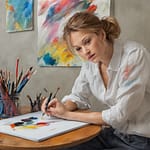Table of Contents
Being a digital painter, and because AI-generated “art” has been in the news lately, I often get people asking what AI I used to create a given painting. Well… I don’t use AI. All of my work is created by hand (within computer software) to recreate a vision and image I have in my mind before I start to work on a new piece. I spend a lot of time fine-tuning the details to get the painting to match my imaginary image.
Further, I am prepared to categorically state here and now that, in my opinion, AI-generated “art” is not art at all!
Am I Anti-AI?
Absolutely not! I do not object to AI per se. It’s here, it’s rapidly evolving, and is unstoppable. It is, arguably, the biggest technical advance we’ll see.
AI is not just here to stay, it’s becoming ubiquitous. Its presence will only increase dramatically in our lifetime – just like the personal computer and the Internet were once considered passing fads!
It is becoming increasingly important in many facets of our lives (many you likely are unaware of). Artificial Intelligence has greatly enhanced scientific research in fields such as astronomy (finding new stars and planets) and medicine (diagnosis, discovering new drugs, and helping restore function to disabled people). AI has also proven beneficial when applied to specific use cases in closed systems (e.g.: in robotics). When regulated and used for good, AI is (and will continue to be) a significant boon to our civilisation. I embrace this wholeheartedly.
Unfortunately, in addition to its myriad beneficial uses, it also has uses that are not helpful at all – some are actually harmful. A current concern is the deliberate use of this technology to create deep-fake images or videos, as well as text-based misinformation (e.g.: articles and posts). I will cover the pros and cons of AI text generators in a separate article.
To sum up: I’m in favour of AI and welcome it’s benefits – but I strongly object to a few specific use cases of AI. AI is not evil, it’s how it’s used that can be a problem. When used for good, it’s a boon to humanity. When used with bad intentions, it is anything but!
The point of this article is to focus on a single narrow use case: public access to AI image generators being used to produce “art.”
What is Art?
To determine whether AI-generated imagery is art, we first need to understand what art is. The generally accepted definition of visual art is: “the use of the imagination to express ideas or convey feelings and emotions through a medium such as drawing, painting, or sculpture.” While humans have imagination, a computer algorithm does not.
Art is made by a human mind, directing the creation of an image or object. It must be purposeful, and guided by imagination, vision, creativity, and skill – with the goal of stirring an emotional response in the viewer. This is true whether the art is painted, sculpted, or created by a digital artist using a computer in lieu of brushes and pens.
Does AI Art Fit This Definition?
An AI does not create with intent. It generates an image that is not just mindless, but soulless – there is no purpose, intellect, imagination, or creativity behind it. A computer algorithm (even if called artificial “intelligence”) is not an “intellect.” A computer program can never “feel,” and has no understanding of, or experience with, human emotions. Therefore, it cannot express emotions, nor stir them in a viewer. AI-generated images cannot in any way be considered to be art. In many ways, these images can be quite random.
What is the AI Art Process?
To create an AI imge, the human operator types in a prompt to guide the AI. For example, “Create a high-definition image of a pretty latino woman with flowers in her hair.” The AI will then generate an image. If you had something in mind when you entered this prompt, you’re unlikely to see it in the generated image. It will be a complete surprise!
Further, although a human operator can modify the resulting image by spending a lot of time refining the text prompt fed to the AI (this is clled “prompt engineering“), the amount of fine control that a human artist can exercise over colouring, detail, composition, and the selection, form, and position of objects is simply not there with AI. No matter how good you become at prompting, the generated image will always contain surprises and compromises.
Not being in complete control of the outcome is rolling dice rather than creating with purpose. Causing an interesting looking image to be created by surprise is not an act of artistic vision and creation. One can also further argue that no part of the AI process involves either artistic skill or technique. I challenge anyone to duplicate one of my digital paintings using an AI image generator and prompt engineering alone.
At this pont in time, AI also has several weaknesses, notably: hands, legs, and full human figures.
There Has Already Been Controversy
Recently, AI-generated art has been entered into some art and photography contests. When revealed after-the-fact that these entries were AIs, and not paintings or photographs, there was an outcry from the contest organisers and the other contestants. As a result, some contests have decided to ban AI submissions completely, while others have created special categories for them where they will be judged only against their peers.
The “Digital Painting” subreddit (category) of online social platform reddit, has now banned all AI art from being submitted as a digital painting. The moderator stated that this subreddit “is for people who want to get better at painting, not writing prompts. If I find you posting AI generated images, you will receive a permanent ban.” One subreddit member commented, “I love these folks saying ‘I made this AI-generated art myself’ … It’s like passing along take-out as a home cooked meal without even taking it out of the box.“
Lack of Originality
Because of the way these AIs work, there is a controversy over the originality of the generated images. The AI is trained on a data set of millions of existing images from the Internet, and uses these as part of its process to generate a new image.
There are several lawsuits already pending by artists and photographers who feel that an AI is using their work without their permission, and with no compensation. It’s hard to say how this will play out… but it will be interesting.
An Example…
For example: one graphic-generating AI called Raquel-IA, generates “art” that consists of a collage of two to three easily-recognisable classic art images with coloured geometric shapes and lines superimposed. Because the images it uses are in the public domain, this AI avoids the copyright issue.
This AI was used recently in my town at a local gallery event. One individual I know of came to see the AI, and also to create some “art.” He sat down at the gallery’s computer, and typed a quote from a famous philosopher. He added his signature to the resulting image, had it printed and framed, and proudly proclaimed that he had created a new work of art. Great… but let’s analyse this…
The prompt upon which this piece of “art” was created was not an original idea, but a quote from someone else. It also did not remotely describe a theme, composition, or colour palette (i.e.: the sort of information you’d give to a human artist to start a commissioned piece).
The resulting “painting” was a digital collage of photos of three existing art works (including Marcel Duchamp’s sculpture “Fountain“).
Neither the concept, the content, nor the style were in any way original. The “artist” had no fine control over the composition or selection of the elements of the piece. He was, in fact, surprised with the result. In spite of this, this “artist” was convinced that he (not the AI!) had created a piece of “art.” Unfortunately for the art world, many other people in this situation might feel the same way.
What’s Really So Bad About This?
It might have the effect of making professional fine art unsustainable. Artists in a local market cannot support themselves solely on sales from educated art patrons – unless they’re extremely talented, or very lucky. The reality is that most of us depend on sales to the average person looking for something to beautify their walls.
Unfortunately, to the untrained eye of the public, these AI images might appear to be legitimate art. Further, because there’s no labour or expensive materials involved, they’re quite inexpensive. This has the effect of “dumbing down” a local art market with cheap non-art that lacks any creativity, effort, passion, or human connection. After enough time, this might become the accepted standard.
Fine art takes a great deal of thought, and a lot of work to produce. The artist hopes that their work will inspire feelings and emotions in the viewer, such that they want to own the piece so that they can continue to feel whatever the work inspired in them whenever they look at it in their home.
When all this is eroded, we’re left with a lot of houses and apartments filled with soulless and meaningless “art.” This is not good for art and artists – nor is it good for society!
Is AI Image Generation Good for Anything?
It does have its uses for graphic design and illustration where it is not being passed off as fine art. Examples might include advertising and promotion, blog post images, illustrations for magazines, etc. AI might provide a quick acceptable image for illustrative purposes, and reduce the workload of a grahic designer.
However, for more complex illustrations, it suffers from the same limitations as using it for fine art – the lack of fine control over the outcome, and the element of surprise in the results.
Conclusion: Should a Fine Artist Use AI?
In my opinion, no!
AI is simply not capable of generating art that conveys or stirs emotion. There is no true control over the details such as composition, colour, or mood. Using AI can send you down a rabbit hole if you’re trying to create a piece that matches a vision you have in your mind. You can spend hours upon hours doing prompt engineering trying to get the exact image you’re looking for – and never succeeding. You wind up compromising.
If you are a true artist, you are already capable of producing a physical realisation of an image in your head – and in your unique style. What, then, can AI do for you? A simple answr: nothing.




